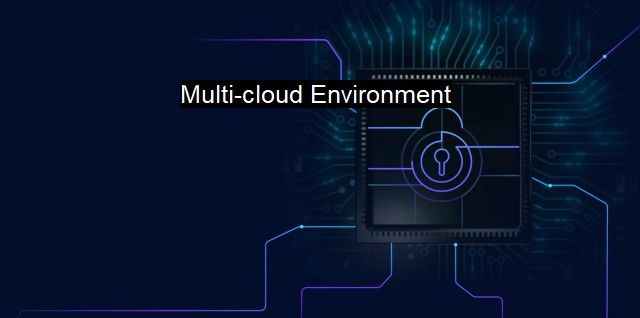What is Multi-cloud Environment?
Securing Multi-Cloud Environments: Navigating Cybersecurity Challenges for Modern Organizations
A multi-cloud environment refers to the strategic deployment of cloud computing services selected from different vendors. Various data storage facilities, network elements, or digital applications could be a part of this distributed infrastructure based on suited business needs such as scalability, operational flexibility, and most importantly, optimizing security levels. Universities or large enterprises leverage such environments to offset the risk of relying on a single service provider, mitigating the possibility of a single point failure.In practical terms, the decision to adopt a multi-cloud environment is essentially similar to not putting all your eggs in one basket. It allows businesses to use different cloud solutions from various providers simultaneously to meet their diverse requirements and virtually unexpected situations. The use of these could vary across infrastructure as a service (IaaS), platform as a service (PaaS), and software as a service (SaaS) models.
With this dispersion of data and services across multiple providers in multi-cloud environments can be advantageous. If an attacker manages to breach the security of one cloud service provider, only a portion of the operation is compromised as opposed to the entire organization astutely clustered in the cloud environment.
Vice versa, the usage of multi-cloud strategy puts forth the challenge to maintain consistent cybersecurity measures across different cloud environments effectively. Such situations may require a diversifying approach and nuances among individual vendors. Also, manual configuration and management might leave room for errors potentially leading to exploitable vulnerabilities.
These vulnerabilities are exponentially dangerous in today's digital society as they open doors to cyber-attacks like ransomware, data leakage, denial of service attacks, and more. It’s here the concept of robust antivirus solutions chip in not only to safeguard your system but to maintain seamless operations in the multi-cloud environment.
Leveraging the power of diversified antivirus programs secures scattered cloud platforms simultaneously. Robust antivirus programs designed to deal with multi-cloud environment check for threats in real time and take immediate actions. They apply heuristic approaches to analyze and identify threats even before they make a headway into the system. with machine learning and artificial intelligence capabilities, an antivirus adapts to new forms of cyber-attacks and safeguards organization resources.
Cybersecurity tactics for multi-cloud environments aren't solely about active defense using antivirus solutions. Regular auditing of security policies, implementation of multi-factor authentication, encryption of sensitive data at rest and in transit, using intrusion detection and prevention systems, are are just as integral in fortifying protections.
Limiting user access based on roles and responsibilities within an organization can further provide a barrier against security breaches in a multi-cloud setting. Tightening security configurations as per best practices of individual cloud service providers ensures reducing the attack surface.
It is vital to have a deep understanding of security measures implemented by cloud service providers while considering multi-cloud strategies. Awareness about the level of control you have over your data and the level of access privy to the providers is also a necessary checkpoint in this scenario. After all, security in a multi-cloud environment is a shared responsibility between the enterprise and the cloud provider.
Multi-cloud's popularity has grown over the years mainly for its flexibility, increased resilience, and minimized vendor lock-in risk. if not properly managed and secured, the benefits can quickly dissipate. Given the significant rise in cyberattacks over recent years, multi-cloud environments need all the cyber-protection they can afford that encompasses powerful antivirus solutions, optimal data encryption, consistent policy enforcement, and constant vigilance. It's about combining and syncing the right tools, processes, and tactics that level up with the sophistication and frequency of today's imminent cyber threats.

Multi-cloud Environment FAQs
What is a multi-cloud environment and why is it important in cybersecurity?
A multi-cloud environment is a system that uses multiple cloud computing services from different providers. It is important in cybersecurity as it reduces the risk of a single point of failure, leading to a more resilient infrastructure.How does antivirus software work in a multi-cloud environment?
Antivirus software in a multi-cloud environment is typically deployed on each cloud instance to monitor and prevent malware and other attacks. Alternatively, a centralized antivirus management system can be used to manage and monitor antivirus software across all cloud instances.What are the potential security risks of a multi-cloud environment?
Some potential security risks of a multi-cloud environment include data breaches, misconfiguration of security settings, and lack of visibility and control over data and applications across multiple cloud providers.How can organizations ensure cybersecurity in a multi-cloud environment?
Organizations can ensure cybersecurity in a multi-cloud environment by implementing a comprehensive security strategy that includes regular security assessments, encryption of data, strong access controls, and continuous monitoring of network activity across all cloud instances.| | A | | | B | | | C | | | D | | | E | | | F | | | G | | | H | | | I | | | J | | | K | | | L | | | M | |
| | N | | | O | | | P | | | Q | | | R | | | S | | | T | | | U | | | V | | | W | | | X | | | Y | | | Z | |
| | 1 | | | 2 | | | 3 | | | 4 | | | 7 | | | 8 | | |||||||